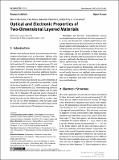Optical and Electronic Properties of Two-Dimensional Layered Materials
Author(s)
Bernardi, Marco; Ataca, Can; Palummo, Maurizia; Grossman, Jeffrey C.
DownloadBernardi-2017-Optical and Electronic Propertie.pdf (4.172Mb)
PUBLISHER_CC
Publisher with Creative Commons License
Creative Commons Attribution
Terms of use
Metadata
Show full item recordAbstract
Modern semiconductor devices have revolutionized wide ranging technologies such as electronics, lighting, solar energy, and communication [1]. The semiconductor industry employs Si to fabricate electronic circuits, and GaAs, GaN, and other III–V materials for optoelectronics [2], with typical substrates consisting of wafers manufactured at high temperature. Precisely controlled thin films can be deposited on the substrate to achieve additional functionality, for example by chemical vapor deposition (CVD) or molecular beam epitaxy [3].
Recent research has focused on a new generation of atomically thin films of semiconducting materials. Guided by the rise of graphene [4–7] – itself a semimetal – a broad family of two-dimensional (2D) semiconducting materials have been fabricated in monolayer, bilayer, and few-layer form [8, 9]. Monolayer 2D materials can be prepared by exfoliating layered crystals in which the layers are held together by weak van der Waals forces [5], or in select cases by CVD [10–12]. While exfoliation is still the main choice in scientific research, CVD fabrication will be important to scale up manufacturing of 2D materials to large areas.
Monolayer and few-layer semiconductors possess novel combinations of optical and electronic properties [7, 8, 13, 14], and thus present a unique opportunity in condensed matter research and semiconductor devices. New physics arises in 2D semiconductors, largely due to the peculiar electronic structure and screening in 2D systems. As the techniques to grow 2D materials on large areas continue advancing, the new properties of these materials may enable a paradigm shift in semiconductor-based technologies, and lead to flexible and ultrathin electronic [14, 15] and optoelectronic devices [16].
This review covers the state of the art in the optical and electronic properties of 2D materials, with a focus on semiconducting systems. Metallic monolayers are also discussed briefly. Our aim is to highlight a few essential concepts emerging from the vast and rapidly growing literature on 2D materials, and suggest future research directions and challenges.
Date issued
2016-01Department
Massachusetts Institute of Technology. Department of Materials Science and EngineeringJournal
Nanophotonics
Publisher
Walter de Gruyter
Citation
Bernardi, Marco et al. “Optical and Electronic Properties of Two-Dimensional Layered Materials.” Nanophotonics 6, 2 (January 2017): 479-493 © 2017 M. Bernardi et al
Version: Final published version
ISSN
2192-8614
2192-8606